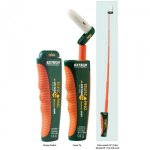I got a non-contact tester with adjustable threshold. Home Depot, Lowes, and Ace Hardware don't sell the Fluke kind that Mike recommended, so I got another kind with threshold adjustable between 12 V and 600 V. I just want to know that those that are not "technical" if you buy this "adjustable" kind, you have to "learn" how to use it, so that you don't freak out from false positives.
Personally, I was able to adjust it using a known good 110 Volt receptacle. Mike, this might be another how-to for your youtube collection

Another note, when doing the hot skin test with the adjustable kind like I purchased. It will sense wires in the trailer wall with its sensitivity turned up this is not hot skin. That's one of the things its made for is to warn you if there are live wires in a wall that you are about to start cutting or drilling holes into.
If it beeps on the step or touchng the door handle that's bad. If it beeps with the sensitivity turned up when held near the outdoor outlet most Heartland RV have somewhere not too far from the door that is very likely not bad.


